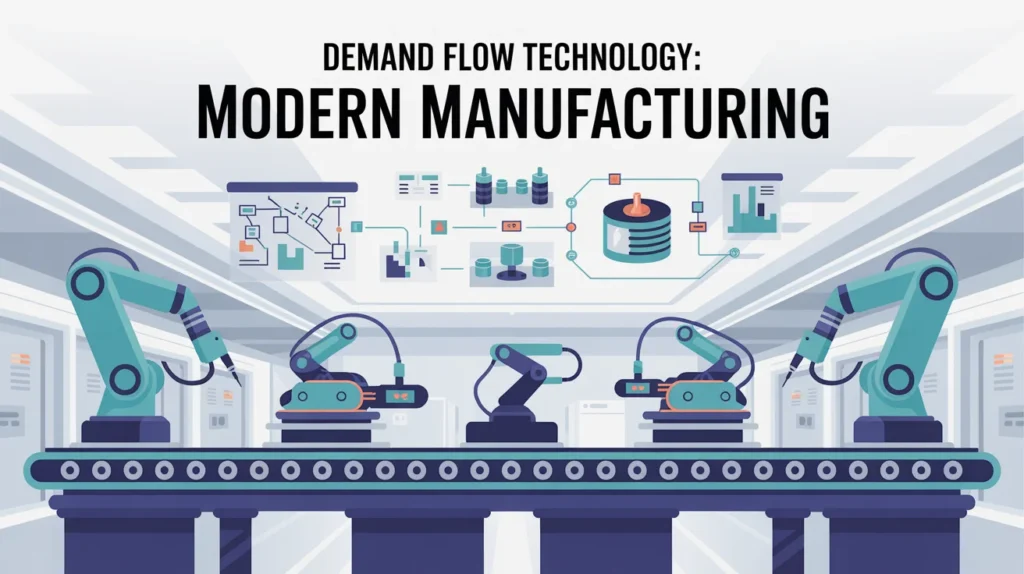In today’s dynamic manufacturing landscape, aligning production with actual customer demand is paramount. Demand Flow Technology (DFT) emerges as a strategic approach that synchronizes manufacturing processes with real-time market needs, minimizing waste and enhancing efficiency. By transitioning from traditional forecast-driven models to demand-driven systems, businesses can achieve greater agility and responsiveness.
Understanding the Core Principles of DFT
DFT is rooted in lean manufacturing principles, emphasizing the elimination of waste and continuous improvement. It focuses on producing only what is needed, when it’s needed, and in the exact quantity required. This approach not only reduces excess inventory but also ensures that resources are utilized optimally.
Benefits of Implementing Demand Flow Technology
Adopting DFT offers numerous advantages that can transform manufacturing operations. By aligning production closely with customer demand, companies can enhance efficiency, reduce costs, and improve customer satisfaction.
- Reduced Inventory Costs: Producing based on actual demand minimizes the need for extensive inventories, leading to significant cost savings.
- Enhanced Flexibility: DFT enables manufacturers to adjust to changes in customer preferences and market trends quickly.
- Improved Quality: Continuous monitoring and adjustment lead to higher product quality and fewer defects.
- Shorter Lead Times: Streamlined processes ensure faster delivery of products to customers.
- Increased Customer Satisfaction: Meeting customer demand promptly enhances trust and loyalty.
Steps to Implement Demand-Based Planning
The first step in implementing Demand-Based Planning is to assess your current manufacturing processes thoroughly. This helps identify inefficiencies, bottlenecks, and areas where production does not align with actual customer demand. Understanding the baseline is crucial before making any changes.
Next, it’s essential to involve and train your workforce. Employees must be educated on DFT principles so they understand the purpose behind the transformation. Their support and engagement are vital to ensuring a smooth transition and ongoing success.
Finally, develop a clear DFT strategy and begin implementing it in phases. Begin by testing the approach in pilot areas, monitoring the results, and making adjustments as necessary. Continuous improvement and real-time monitoring are key to sustaining the benefits of DFT over time.
Challenges in Adopting Demand-Based Planning

While DFT offers significant benefits, organizations may encounter challenges during implementation. Recognizing and addressing these obstacles is crucial for a smooth transition.
- Change Management: Transitioning from traditional methods to DFT necessitates cultural and operational adjustments, which may encounter resistance.
- Data Accuracy: DFT relies on real-time data; inaccuracies can disrupt the entire system.
- Integration with Existing Systems: Ensuring compatibility between DFT and current technologies can be a complex process.
- Resource Allocation: Implementing DFT may require significant investment in training and infrastructure.
Real-World Applications of Demand-Driven Manufacturing
Demand Flow Technology (DFT) has transformed how industries respond to changing customer needs. In manufacturing sectors like automotive, electronics, and aerospace, it enables real-time production adjustments based on demand signals rather than forecasts.
This minimizes overproduction, reduces inventory holding costs, and enhances customer satisfaction through faster delivery cycles.
In the healthcare, retail, and FMCG industries, DFT improves supply chain responsiveness and inventory accuracy. Hospitals use it to ensure critical supplies are available without excess, while retailers apply it to maintain optimal stock levels, preventing both stockouts and overstocking.
By applying DFT principles, these industries experience improved agility, reduced waste, and enhanced operational efficiency.
Technological Tools Supporting DFT
The successful implementation of DFT is bolstered by various technological tools that facilitate real-time data analysis and process optimization. These tools enhance the responsiveness and efficiency of manufacturing operations.
- Kanban Systems: Visual tools that signal the need for inventory replenishment, ensuring smooth workflow.
- Value Stream Mapping: Analyzes and designs the flow of materials and information to identify waste.
- 5S Methodology: Organizes the workplace to improve efficiency and safety.
- Total Productive Maintenance (TPM): Focuses on proactive maintenance to prevent downtime and defects.
Future of Just-in-Time Production
Just-in-Time Production is evolving rapidly to meet the changing needs of global manufacturing. As digital transformation continues to spread, DFT is expected to integrate more closely with advanced technologies such as AI and the Internet of Things (IoT). This shift will enable businesses to make smarter, faster decisions in real-time.
In the future, DFT will also support more sustainable and eco-friendly manufacturing practices. By reducing waste, lowering energy usage, and optimizing resources, it aligns well with global sustainability goals. As industries prioritize agility and environmental responsibility, DFT will remain a critical tool for long-term growth.
Conclusion
Demand Flow Technology represents a paradigm shift in manufacturing, emphasizing responsiveness, efficiency, and customer-centricity. By aligning production with actual demand, businesses can reduce waste, lower costs, and enhance customer satisfaction. While implementation may pose challenges, the long-term benefits of DFT make it a compelling strategy for modern manufacturers aiming to thrive in a competitive landscape.
Frequently Asked Questions:
Q1: What is the primary goal of Demand-Driven Manufacturing?
A1: To align production processes with actual customer demand, reducing waste and improving efficiency.
Q2: How does DFT differ from traditional manufacturing methods?
A2: Unlike forecast-driven models, DFT relies on real-time demand to guide production decisions.
Q3: Can small businesses implement DFT?
A3: Yes, DFT principles can be scaled to fit businesses of all sizes, enhancing their responsiveness and efficiency.
Q4: What industries benefit most from DFT?
A4: Industries with fluctuating demand patterns, such as automotive, electronics, and consumer goods, benefit significantly from DFT.
Q5: Is DFT compatible with existing ERP systems?
A5: DFT can be integrated with ERP systems, but it may require customization to ensure seamless operation.




